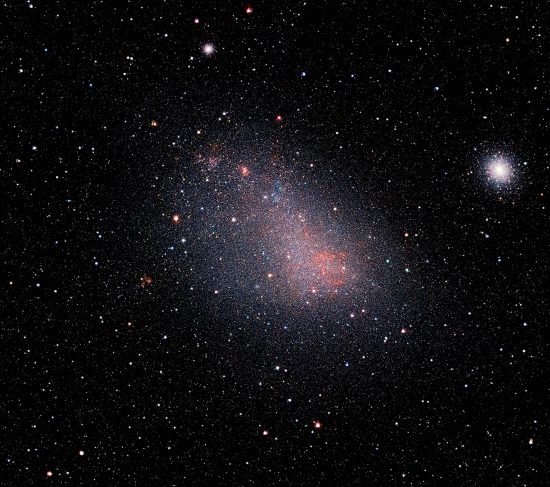March 1, 2018
What gives a globular cluster its structure?
The Visible and Infrared Survey Telescope for Astronomy (VISTA) began operations a day after its December 11, 2009 dedication ceremony. One of its major contributions is the ability to “see through” dust clouds that obscure background objects. In the image at the top of the page, VISTA draws back the curtain on the Small Magellanic Cloud, revealing millions of previously unseen stars. The image also includes a sharper construct of the bright globular cluster, 47 Tucanae.
Spherical clusters of stars are one way that plasma organizes itself into coherent formations. They are a problem to conventional astronomers because they think that globular clusters start life from a single birthing event. Globular clusters are not rich in the gas and dust needed for new stars. Their confusion exists because one of the Milky Way’s globular clusters, 47 Tucanae, contains “multigenerational” stars, something that should not be.
When gravitational models of the cosmos are considered, globular clusters are outside the bounds of gravity’s abilities. Why do they evolve into spheres instead of disks or ellipses? Stars near the outside of a globular cluster should be accelerated out of the cluster, while stars closer to the center should further condense into tighter knots. Therefore, they should dissipate over time.
Globular clusters orbit galaxies in a halo, so each time they cross a galactic plane, tidal forces should disrupt them, sending their stars every which way. Why this does not happen is not explained. 47 Tucanae is supposed to be hundreds of millions of years old, yet it remains spherical despite crossing the plane of the Milky Way many times.
In an Electric Universe, stars are positively charged objects bound together by electric and magnetic fields, so their interactions with each other are not based on a kinetic (gravity) model of the Universe. The Electric Star model insists that it is the strength of electric charges flowing into stars that determines their characteristics.
The Nebular Hypothesis is inexact when it comes to analyzing a star’s behavior in galactic formations or globular clusters. Populations of stars are not dependent on how long it took them to evolve, according to Electric Star theory, so the “problem” with multigenerational stars in 47 Tucanae does not follow.
Electrically, individual stars might be considered as discrete charged particles, behaving according to the laws of plasma physics and not the laws of mechanical motion. Galactic disks act like Faraday motors, while globular clusters (as has been suggested in the past) might be more like ball lightning than anything else.
So, 47 Tucanae is acting in accord with electrical concepts. Its stars are probably not that old (as astronomers count age), because they behave according to a plasma cosmology hypothesis.
Stephen Smith
With apologies to Norman Whitfield, Barrett Strong and the Temptations













